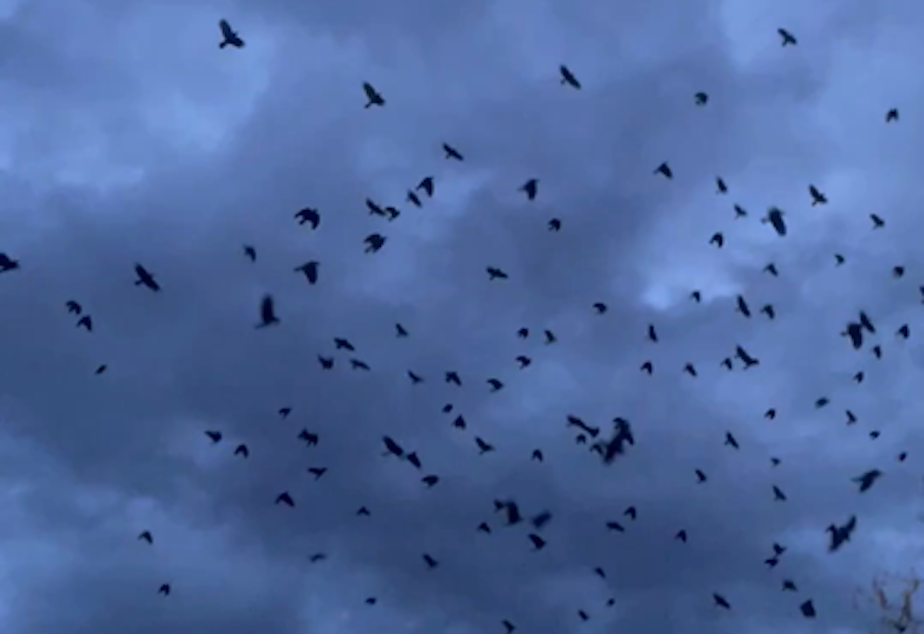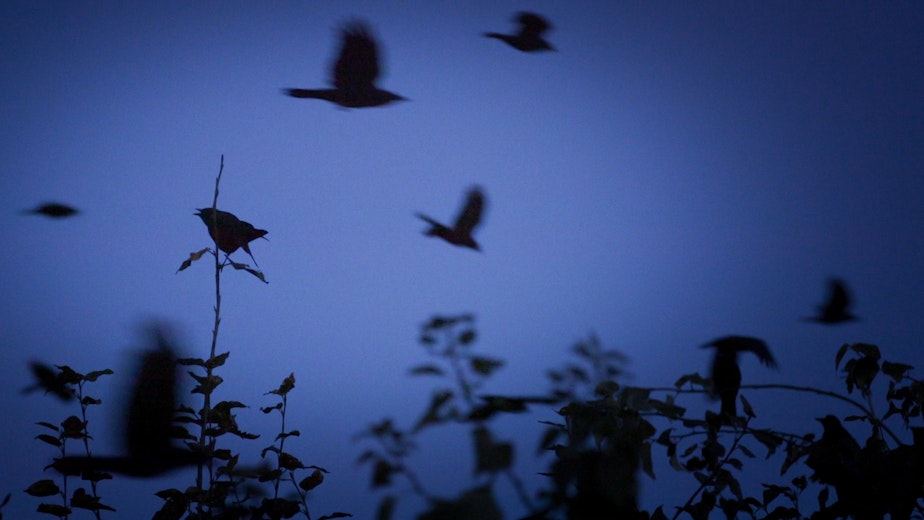Seattle crows are so smart, they’re challenging what we know about evolution

Researchers have made startling discoveries in recent years about a crow’s ability to communicate, solve problems, remember people, and use tools. What they’re discovering about crow brains is changing how scientists understand intelligence — and bringing into question our accepted version of evolution.
A 2020 study demonstrated for the first time that carrion crows, the European relatives of American crows, have subjective experiences — “sensory consciousness” — a level of thinking previously thought to be limited to humans and other primates. New Caledonian crows are smart enough to create their own tools — in the wild and the lab — by shaping one end of a stick or wire into a hook to retrieve food beyond the reach of their beaks. In 2024, researchers in Germany taught crows to count out loud, using vocalizations to correspond with numerical values.
RELATED: Seattle crows, beloved and feared, may be playing us with their primate-sized brains
Despite these discoveries, the question of how crows, which do not have a prefrontal cortex like humans and other mammals, are capable of high-level thinking, has largely remained a mystery.
“That always was kind of the black box,” said John Marzluff, a professor of wildlife science at the University of Washington who has pioneered the study of crow intelligence. “When they do these really great things, is it just some more robotic response or is it really a reasoned response?”

Crow awareness and intention used to be something about which scientists could only speculate. Now, researchers like Marzluff can measure and plot the brain activity of crows to better understand how they process information, make decisions, and confront problems.
Scanning crow brains
Marzluff and his team at the University of Washington were the first to look at crow brains during experiments using a PET scan, a noninvasive technology that uses a radioactive tracer to detect which parts of a brain are active at a given moment.
You may recall Marzluff’s findings that crows recognize humans and remember their faces (or the “caveman” masks they were wearing). As part of that study, researchers looked at what parts of the crow brain were activated when encountering people wearing the same “caveman” masks scientists wore when capturing the crows, versus the “caring” masks worn by researchers who fed and cared for the crows during their captivity.
That same method, using PET scans to see what parts of crow brains are activated in different situations, is now being used by one of Marzluff’s protegees, Loma Pendergraft, who teaches animal behavior in the UW Department of Psychology.
Sponsored

In Pendergraft’s most recent crow study, he looked at what happens in a crow’s brain when it uses tools. The problem, at least initially, was that, unlike New Caledonian crows, American crows aren’t big tool users.
“American crows don’t really need to use tools in their day-to-day lives. They can find food just fine,” Pendergraft said. “They’re capable of learning how to do it. They’re just not regular tool users.”
Pendergraft structured his experiment around one of Aesop’s Fables — a thirsty crow finds a pitcher of water, but the water level is too low for the bird to reach. So, the crow drops pebbles into the pitcher until the water rises high enough for the crow to drink.
But getting the crows to obtain the desired reward, in this case a single Cheeto placed atop the low water line, was far from easy.
Sponsored
Only the wiliest birds, mostly smaller females, figured out how to take pebbles in their beaks and put them in the water to raise the level to snatch the Cheeto.
“Those four birds that had fully mastered the task, we saw a complete shift in brain activity compared to their less-capable peers,” Pendergraft said. “It switched over to areas of their brain that are associated with muscle memory and motor control.”
Pendergraft compared the shift to an Olympic skier visualizing their route down a well-known ski slope. The skier doesn’t have to think about how to stay balanced or how to turn. They have mastered those basics.
“They’re visualizing the route they’ll take and the technique they’ll use, but it’s all muscle memory,” he said.
Sponsored
Ask the crow
Andreas Nieder and his colleagues at the University of Tübingen in Germany wanted to see if crows could experience the world in a subjective way.
Because crows don’t have a prefrontal cortex, it was long thought they could not interpret something based on their own perceptions.
Nieder and his team taught crows to respond when they saw a signal shown on a screen.

RELATED: Crows can count out loud like human toddlers — when they aren't cheating the test
“The neurons that have been found in humans and monkeys, and now it's in crows, are behaving exactly the same way,” he said. “They're switching their activity, not as a function of the visual input, but as a function of the subjective perception of the organism.”
Bird Brains
This discovery of subjective experience in an animal that lacks a prefrontal cortex throws a bird-shaped wrench into our understanding of evolution.

Because bird brains appear to be less developed than primate brains, scientists have long believed birds were incapable of high-level functions known to take part in the prefrontal cortex, like problem-solving, decision making, developing plans, and maintaining a working memory.
But what Nieder says his research suggests is that, in the 320 million years since birds and primates split, each has developed different brain structures, but those differently composed brains have developed similar cognitive capabilities.
“It seems that evolution invented a different anatomical structure to give rise to the same physiological properties, and therefore also cognitive behaviors,” he said.
Nieder compared the two very different brain structures to the wings of birds, versus the wings of bats or flying insects.
“The wings look very different,” he said. “But the function is the same.”
Sponsored
Crow talk
While Nieder, Pendergraft, and Marzluff have focused much of their research on trapping crows and studying them in labs, Doug Wacker, associate professor of animal behavior at the University of Washington Bothell, prefers to document crow behavior and communication in their natural environment.

 21 secs
KUOW's Kim Malcolm films as thousands of crows return to their roost on the University of Washington Bothell campus.
21 secs
KUOW's Kim Malcolm films as thousands of crows return to their roost on the University of Washington Bothell campus.
Which is convenient, because Wacker works next to the largest roost in the Seattle area, a wetlands restoration project on the eastern edge of the UW Bothell campus that, during certain times of the year, attracts up to 20,000 crows.
RELATED: Only murders in the roost: What springtime means for Seattle-area crow 'slumber party'
Sponsored
Wacker said the communal roost is often confused with a giant nest. In fact, during breeding season, crows pair off and disperse to their personal territory, where they build a nest, lay eggs, and raise their fledglings. It is only during non-breeding season, the rest of the year, that the crows flock by the thousands to Bothell at dusk to sleep in the trees.
For close to a decade, Wacker has studied how crows communicate vocally to better understand crow calls and what they mean.
Crows, he points out, are songbirds. But unlike most songbirds, they don’t have a melodious song. Their vocalizations are more varied and aren’t limited to the key function of other bird calls — either to attract a mate or repel a rival.
To help him understand crow calls and their meaning, Wacker uses artificial intelligence to dissect and categorize the acoustics of crow sounds in various settings.
For example, he and his team will put out a model of an owl and play the sound of a crow’s distress call. They will then compare those sounds to the vocalizations crows make at “pre-roosting aggregations,” when they converge on the UW Bothell campus before retiring to sleep in the trees.

Using this data, the computer model can categorize a crow sound with an accuracy level of 80% to 90%, Wacker said.
“We’re nowhere close to having like a big crow dictionary or something like that,” he said. “But we are finding some things.”
New Redmond roost?
Another thing that Wacker and his team have noticed: the Bothell crows might be slowly migrating to a new wetland roost in Redmond.
Last year Wacker and his fellow crow counters tallied close to 8,000 crows that flew right past the Bothell roost and continued south to Redmond, the site of another more recent wetlands restoration.

“To my knowledge, no one has ever seen this natural movement from one roost location to another,” Wacker said. “We’re seeing something that hasn’t been described. It certainly has happened, but it hasn’t been described.”
But are crows self-aware?
The debate over whether crows have self-awareness or self-consciousness is ongoing. Crows taking the mirror test — whether an animal that sees itself in a mirror can recognize it as a reflection — have had mixed results.
But Pendergraft pointed out that the mirror test tends to favor animals that are visually oriented and that have hands.
While the question of self-awareness remains, it is likely that crows do possess “theory of mind,” an awareness of the mental states of others, he said.
Crows hide food in hundreds of locations and can remember those exact locations. But when they know they’re being watched by another bird, crows will pretend to hide food and then hold the food in their throat pouch and take it to another hiding spot.

Pendergraft points out that crows only demonstrate this behavior if they themselves have stolen another bird’s food.
“Once they do that, they realize, ‘Oh, wait a minute. If I can steal his food, then he can steal my food,” he said.
Studies have shown that crows and ravens are guarded about hiding food, if they believe they’re potentially being watched. They will even check to make sure other birds haven’t seen their hiding spot and then move their stored food to make sure it stays hidden.
“That implies theory of mind,” Pendergraft said.
Sunsetting the mask experiment
Pendergraft’s mentor, John Marzluff, who is retired, living in Montana, and studying ravens at Yellowstone National Park, hopes to sunset his “caveman” mask experiment during the 2024-25 school year.

Twice a year for 16 years, Marzluff or one of his students has gone out wearing the mask originally worn when crows were captured on the Seattle campus.
Each year, the crows react in the same way. They recognize the mask, call their friends, and “mob” the person wearing the mask. Recognizing whether people are friend or foe is crucial for crows to survive in an urban environment.
“When you’re dealing with humans, you have to be really on your game,” Marzluff said. “Because one of us might shoot you and another of us might befriend you for life and feed you every day.”
But at this point in the “caveman” mask experiment, the birds who were initially captured are all dead, as are most, if not all, the birds who witnessed the initial capture.
Last year, the crow reaction to the caveman mask was the lowest Marzluff has ever recorded. He hopes it will go down even more during the upcoming school year.

“I’d like to get one more measure as a way to see how these behaviors might eventually leave the society,” he said. He expects the crows to eventually realize that the caveman-masked human is no longer a threat.
“It just doesn’t pay to keep scolding this guy,” Marzluff said.




